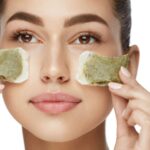Here are top tips from Dr. Allen at Doctor Eye Health on how to tackle puffy eyes and eye bags.
Avoid Sodium-Rich Foods
Diet is an important component of good skincare results. A diet high in salty foods such as fries or processed snacks can lead to puffy eyes. Salt retains water, it’s as simple as that. The less water retention in the under-eye area, the more pronounced your eye bags and puffiness will be.
Cold Compress
A cold compress helps constrict the blood vessels around the eyes, thus reducing eye bags. You can simply relax with a cold compress over your eyes for a few minutes, and it will work its magic quite quickly. If you’ve heard the hype around putting cucumbers on your eyes, Dr. Allen says he has no studies proving that cucumbers themselves (or their antioxidants) are effective and it may just be the coldness. You can use anything from eye masks to cold spoons or even chilled bean bags.

Be Mindful of Eye Allergies
Eye allergies can cause your eyes to turn red, puffy, and watery. If you’re prone to these types of allergies, it’s important to address them. Consult an allergist or ophthalmologist to learn about oral antihistamines and anti-allergy eye drops that may be helpful. Cold compresses can also make a difference. Most importantly: don’t rub your eyes – this will only make things worse.
Surgical Intervention
Some eye bag issues may be a result of aging – and if so, cold compresses and a low-sodium diet won’t be enough to bring about significant changes to your eye area. This is where surgical intervention comes in. Lower eyelid blepharoplasty (or lower eyelid skin tightening) involves a surgeon making an incision below your eyelid and removing some of the puffy fat in the eye socket to create a smoother appearance. The incision is made below the eyelid (not on the surface of the skin) so that when it heals, there is no obvious scarring.






































